Rapid Liquid Printing Market Size and Trends
The rapid liquid printing market is estimated to be valued at USD 74.5 Mn in 2025 and is expected to reach USD 312.1 Mn by 2032, growing at a compound annual growth rate (CAGR) of 22.7% from 2025 to 2032.
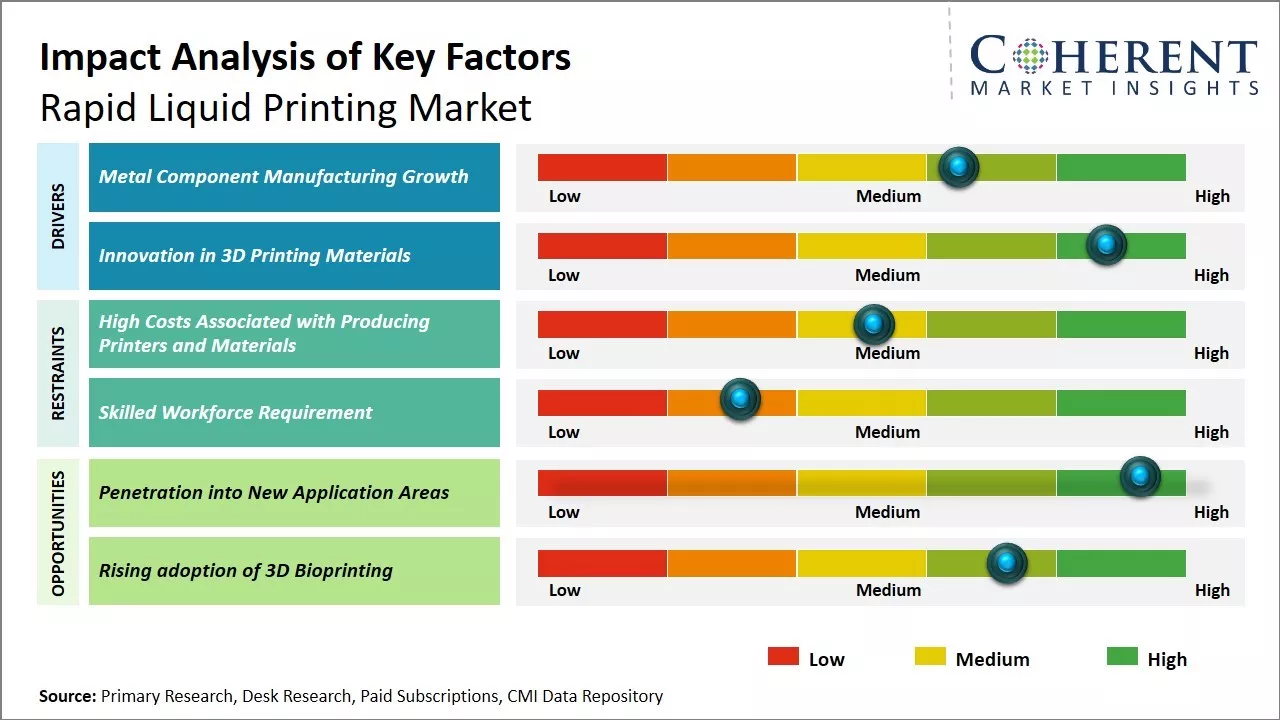
Discover market dynamics shaping the industry: Download Free Sample
The rapid liquid printing market is expected to witness significant growth during the forecast period. This is attributed to the growing adoption and demand for 3D printing across various industries, such as automotive, healthcare, industrial, and consumer goods. Rapid liquid printing helps manufacturers produce intricate and complex designs easily and quickly. Further, rapid advancements in liquid-based 3D printing technologies such as multi-material 3D printing are expanding the application areas of rapid liquid printing in industries. New applications of 3D printing in fields such as dental, prototyping, and medical devices are also fueling market growth. However, high equipment costs and limited materials for 3D printing may hamper market growth during the analysis period.
Metal Component Manufacturing Growth
The rapid growth of metal component manufacturing, especially in the automotive and aerospace industries, is a key driver of the rapid liquid printing market. As 3D printing technology continues to evolve, metal additive manufacturing is becoming increasingly viable for low-volume production runs and custom component fabrication. Rapid liquid printing allows manufacturers to 3D print metal components layer by layer directly from a digital file, offering more design freedom and the ability to produce complex geometries that would be difficult or impossible to create through conventional methods like casting or machining.
Many automotive and aerospace manufacturers are now adopting metal 3D printing to produce parts like lightweight alloy brackets, engine mounts, valves, and turbine blades for jet engines. With rapid liquid printing technologies, they can create metal components that are stronger, yet much lighter compared to traditional cast parts. The weight savings allows for improved fuel efficiency in vehicles as well as increased payload capacities for aircraft. Producing parts through 3D printing is also more economical for low production volumes when tooling or casting molds are not required. As additive manufacturing technologies improve, the cost of 3D printed metal parts is decreasing which will further drive their adoption over time. Overall, the ability to make high-strength, complex custom metal parts cost-effectively is boosting demand for rapid liquid printing across major manufacturing industries.
For instance, in 2021, BMW, a leading automotive manufacturer, invested in the Seed financing round of Rapid Liquid Print. Rapid Liquid Print (RLP) brings the benefits of 3D printing to elastomers with a revolutionary gel-printing technology.
Market Concentration and Competitive Landscape
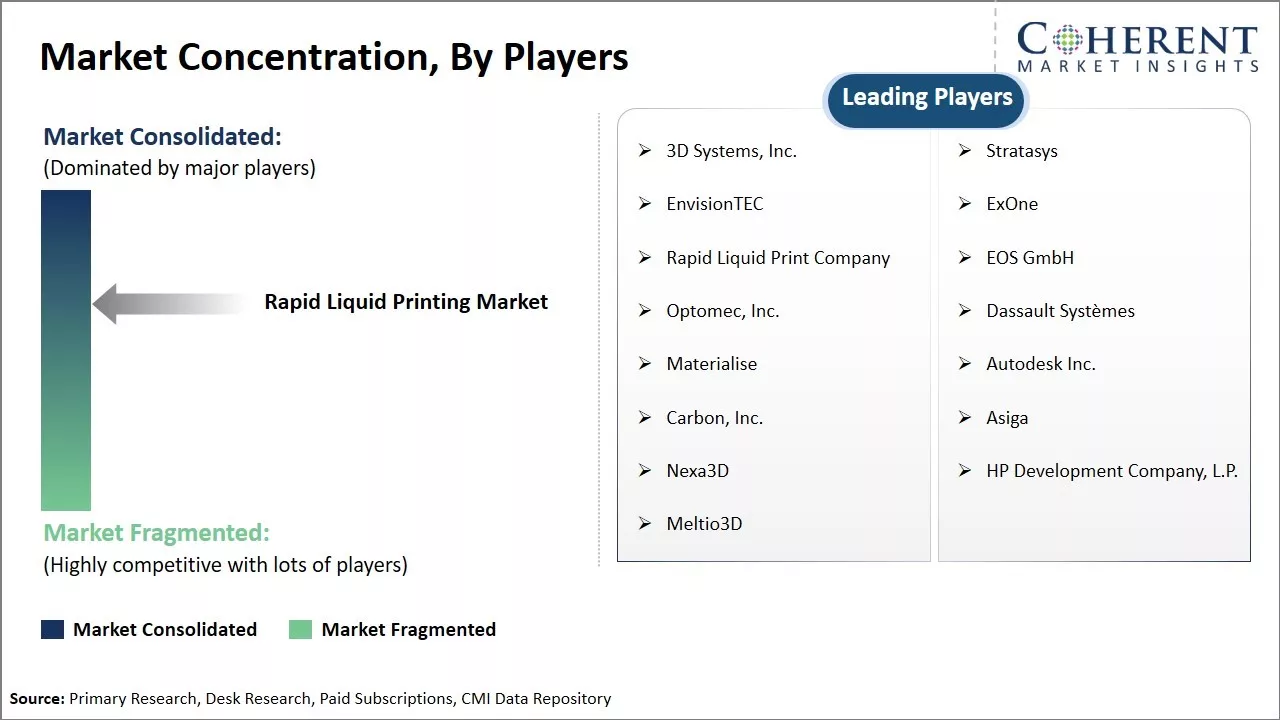
Get actionable strategies to beat competition: Download Free Sample
Innovation in 3D Printing MaterialsThe ongoing innovation in 3D printing materials is another critical driver behind the rapid liquid printing market. Material scientists and manufacturers are continually working to expand the range of metals, alloys and composites that can be 3D printed using liquid-based approaches. While technologies like laser powder bed fusion opened the door for printing common structural alloys like cobalt chrome and aluminum, chemical and bio-compatible material development is expanding the applicability of additive manufacturing. Liquid 3D printing now allows production of reactive metals, titanium alloys and specialized stainless steels needed for medical implants, high-performance turbines and other mission critical applications.
New resins, photopolymers, and nanocomposites are also broadening the functional properties achievable through additive layer manufacturing. Conductive inks and carbon nanotube infused polymers enable rapid printing of electronic components, sensors and lightweight structures with integrated smart capabilities. Bio-compatible hydrogels containing living cells are under development for regenerative tissue applications.
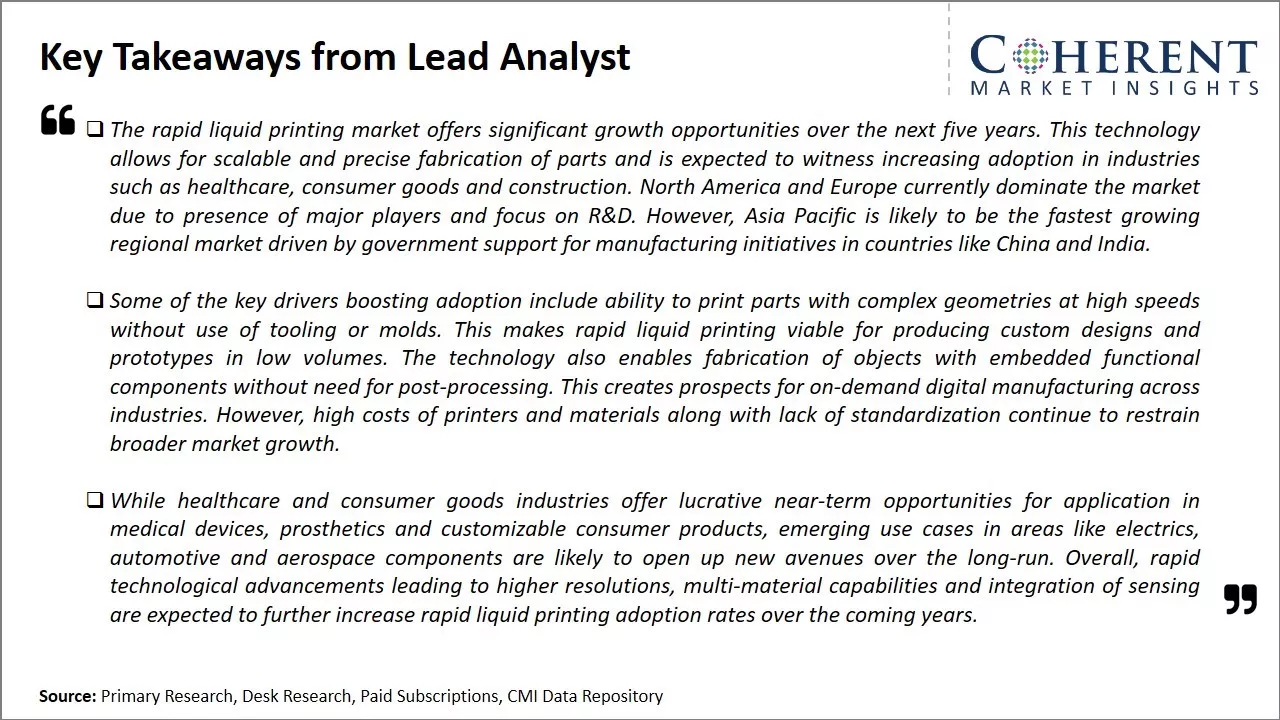
To learn more about this report, Download Free Sample
Market Challenges: High Costs Associated with Producing Printers and MaterialsSome key challenges facing the rapid liquid printing market include the high costs associated with producing printers and materials suitable for 3D printing with liquids. Additionally, the technologies require extensive research and development investments to achieve finer resolutions and higher printing speeds. End-users may also be wary of adopting new techniques until liquid-based printing systems can demonstrate reliability on par with traditional manufacturing methods. Standardization across different machines and file types has also lagged behind powder-based 3D printing.
Market Opportunities: Penetration into New Application Areas
There are substantial opportunities for growth as liquid-based printing opens up new applications. Bio-printing of tissues and organs using cellular inks holds promise for revolutionizing healthcare. Consumer goods companies could utilize liquid 3D printing to mass customize products. Rapid prototyping of parts and tools with novel liquid composites may also see increased adoption. Lower-cost home and desktop liquid printers would make the technology accessible to schools, small businesses.
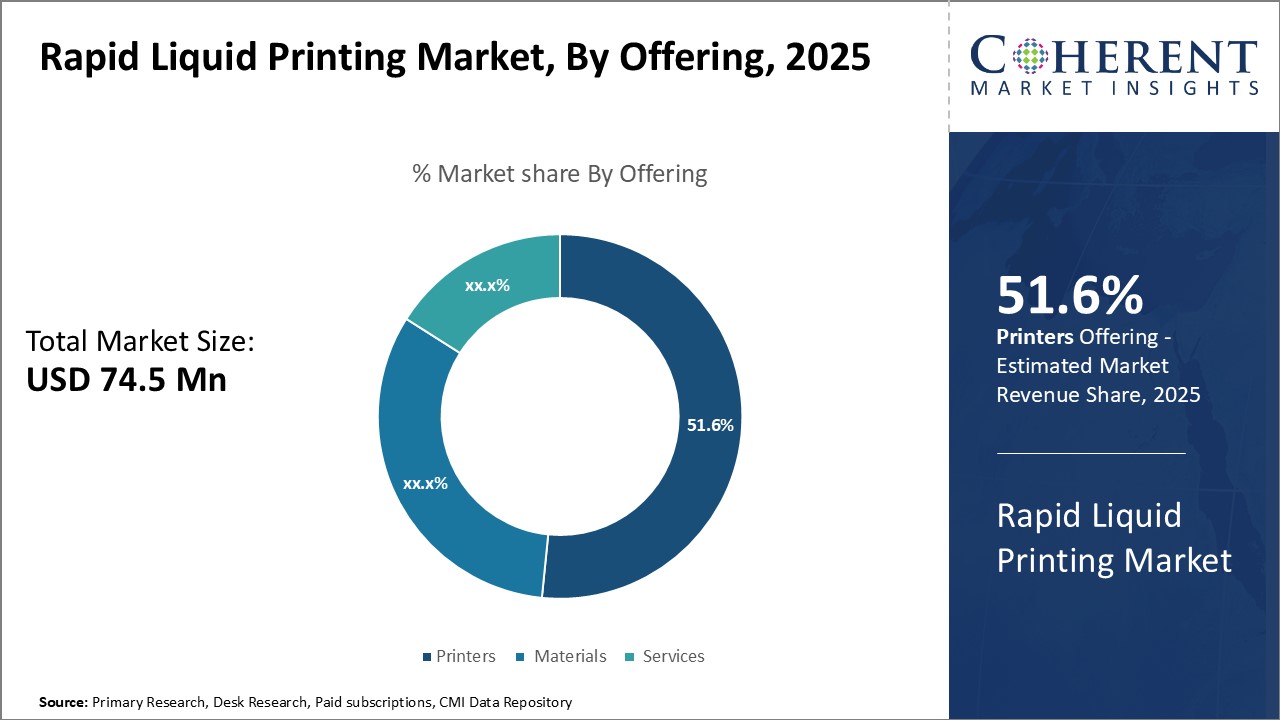
Discover high revenue pocket segments and roadmap to it: Download Free Sample
Insights, by Offering - Rapid Evolution Drives Printers Segment DominanceThe printers segment is estimated to contribute the highest share of 51.6% in the rapid liquid printing market in 2025, owing to continued innovation and improvement in printer technology. Desktop printers remain immensely popular for prototyping and demonstration purposes due to their ease of use and accessibility. Industrial printers are gaining widespread adoption across manufacturing industries as they offer higher build volumes, improved materials compatibility, and seamless integration into production workflows. Major printer manufacturers are consistently enhancing key performance aspects such as printer throughput, dimensional accuracy, and material properties support to expand the scope of applications. The highly customizable nature of liquid-based 3D printing aligns well with the needs of the era of mass customization. The development of multi-material and special effect support capabilities in printers is boosting their uptake. Overall, the rapid evolution in printer capabilities continues to strengthen their stronghold over this market segment.
Insights, by Application - Functional Applications Propel Prototyping's Lead
Prototyping segment is estimated to contribute the highest share of 52.8% in 2025 in the rapid liquid printing market owing to the unprecedented design flexibility and production agility it provides. Functional prototyping using advanced photopolymers allows real product simulations, rapid form and fit verification, intricate design validation, and performance testing. This enables quick design iterations for improved results. The ability to 3D print jigs, fixtures, and tools using the same technology as end-use parts drives operational synergies. As liquid 3D printing processes advance to produce functional prototypes mimicking the properties of injection-molded/cast/machined final parts, their use is expanding from form testing to comprehensive performance testing purposes across automotive, medical, consumer goods and other industries. This is a key driver underpinning prototyping’s dominance in the application segment.
Insights, by End-use Industry - Tailored Solutions Lifts Automotive Industry at the Top
Automotive is estimated to contribute the highest share of 28.7% in the rapid liquid printing market in 2025 owing to its extensive, customized requirements. Liquid 3D printing caters well to automotive manufacturing needs with versatile materials, tight dimensional control and ability to produce complex, lightweight geometries. It allows limitless design experimentation for improved performance. Automotive OEMs and component manufacturers are increasingly adopting these technologies to develop tailored, specific solutions for each vehicle model and accelerate vehicle development programs. Rapid tooling using polymeric materials enhances their just-in-time manufacturing abilities. The growing R&D efforts into alternative materials like elastomers for applications requiring soft-touch and flexibility further fuel its adoption. The capability to custom-manufacture low-volume production parts on-demand gives automakers an edge. With liquid 3D printing playing a prominent role, automotive sector remains the leader in the end-use industry segment.
Regional Insights
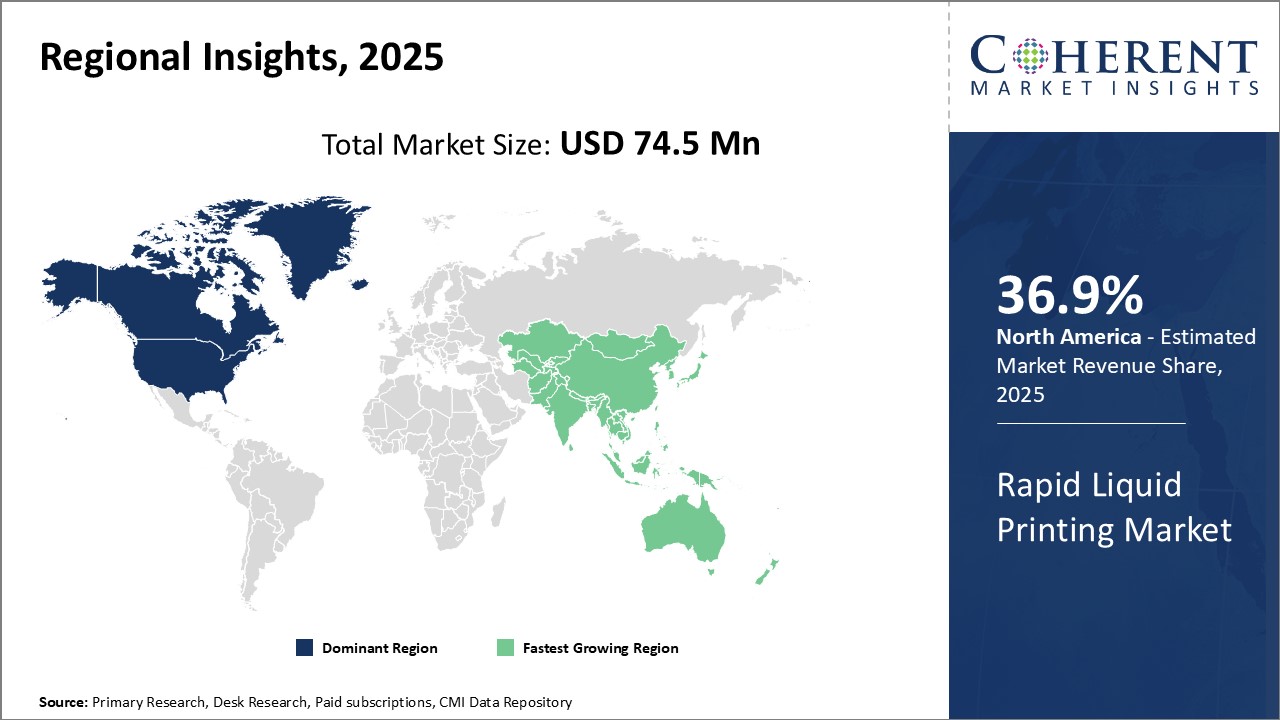
Need a Different Region or Segment? Download Free Sample
The North American region currently dominates the rapid liquid printing market and is estimated to hold the market share of 36.9% in 2025. With the strong presence of leading manufacturers and technological advancements, countries like the U.S. and Canada have established themselves as global leaders in this sector. Several large automotive, healthcare and electronic companies based in this region are actively investing in R&D to utilize 3D printing applications for production.
With supportive government policies that encourage industrial innovations, North American companies have incorporated rapid liquid printing extensively in their manufacturing processes across many industries. This has given the regional market significant scale and experience compared to others. International cooperation is also fostering, with collaborations between companies and research institutions strengthening the ecosystem. With rising demand from end-use sectors, local manufacturers have been able to achieve economies of scale by boosting their manufacturing capacities.
The Asia Pacific region, especially countries like China and India, is witnessing the fastest growth in the rapid liquid printing market currently. This can be attributed to increasing government focus on developing advanced manufacturing capabilities to boost industrial competitiveness. Large-scale investments are being made to set up technical skills development centers and incubate startups focusing on additive manufacturing solutions.
Rising labor costs are propelling the adoption of automated technologies like rapid liquid printing among manufacturers to enhance productivity. Furthermore, expanding exports from leading sectors such as electronics and automotive from the developing countries are augmenting demand. This is encouraging both international as well as domestic manufacturers to establish production facilities and collaborate with regional players. Evolving regulatory guidelines are also providing impetus by easing import/export policies associated with 3D printing goods.
Market Report Scope
Rapid Liquid Printing Market Report Coverage
| Report Coverage | Details | ||
|---|---|---|---|
| Base Year: | 2024 | Market Size in 2025: | USD 74.5 Mn |
| Historical Data for: | 2020 To 2024 | Forecast Period: | 2025 To 2032 |
| Forecast Period 2025 to 2032 CAGR: | 22.7% | 2032 Value Projection: | USD 312.1 Mn |
| Geographies covered: |
|
||
| Segments covered: |
|
||
| Companies covered: |
3D Systems, Inc., Stratasys , EnvisionTEC, ExOne , Rapid Liquid Print Company, EOS GmbH, Optomec, Inc., Dassault Systèmes, Materialise , Autodesk Inc., Carbon, Inc. , Asiga, Nexa3D , HP Development Company, L.P., Meltio3D |
||
| Growth Drivers: |
|
||
| Restraints & Challenges: |
|
||
Uncover macros and micros vetted on 75+ parameters: Get instant access to report
Rapid Liquid Printing Industry News
- In July 2023, Carbon Inc. and the Institute of Polymer Technology (LKT) at Friedrich-Alexander-University Erlangen-Nürnberg announced the opening of a Joint Advanced Design and Development Center in Bavaria.
- In January 2022, Carbon Inc. launched its new M3 and M3 MAX 3D printers that offers improved print speeds, larger build volumes, and higher-quality parts when compared to its predecessors.
- In June 2021, Stratasys introduced the first multi-material desktop 3D printer based on the PolyJet technology. The Stratasys J35 Pro 3D printer is designed to produce prototypes, models and use parts for a wide range of industries, all from the convenience of the office environment.
- In December 2021, Automotive manufacturer BMW’s strategic investment arm BMW i Ventures has provided seed funding to elastomer 3D printing start-up Rapid Liquid Print (RLP). RLP’s breakthrough technology is disrupting the 3D printing space by enabling the rapid printing of elastomeric structures of any size and complexity.
*Definition: The rapid liquid printing market enables the fast and easy creation of three-dimensional objects using liquid materials like polymers and hydrogels. Rapid liquid printers deposit material layer by layer using technologies like inkjet printing heads to rapidly construct physical objects from digital files. Products made through rapid liquid printing are used across industries like manufacturing, healthcare, automotive, and consumer goods for prototyping, molding, anatomical models, and design verification applications where speed and flexibility are important.
Market Segmentation
- Offering Insights (Revenue, USD MN, 2020 - 2032)
- Printers
- Desktop Printers
- Industrial Printers
- Materials
- Services
- Printers
- Application Insights (Revenue, USD MN, 2020 - 2032)
- Prototyping
- Functional/End-use Part Manufacturing
- Tooling
- End-use Industry Insights (Revenue, USD MN, 2020 - 2032)
- Healthcare
- Consumer Goods
- Automotive
- Aerospace & Defense
- Fashion & Accessories
- Electronics
- Power & Utility
- Others
- Regional Insights (Revenue, USD MN, 2020 - 2032)
- North America
- U.S.
- Canada
- Latin America
- Brazil
- Argentina
- Mexico
- Rest of Latin America
- Europe
- Germany
- U.K.
- Spain
- France
- Italy
- Russia
- Rest of Europe
- Asia Pacific
- China
- India
- Japan
- Australia
- South Korea
- ASEAN
- Rest of Asia Pacific
- Middle East & Africa
- GCC Countries
- Israel
- Rest of Middle East & Africa
- North America
- Key Players Insights
- 3D Systems, Inc.
- Stratasys
- EnvisionTEC
- ExOne
- Rapid Liquid Print Company
- EOS GmbH
- Optomec, Inc.
- Dassault Systèmes
- Materialise
- Autodesk Inc.
- Carbon, Inc.
- Asiga
- Nexa3D
- HP Development Company, L.P.
- Meltio3D
Share
Share
About Author
As an accomplished Senior Consultant with 7+ years of experience, Pooja Tayade has a proven track record in devising and implementing data and strategy consulting across various industries. She specializes in market research, competitive analysis, primary insights, and market estimation. She excels in strategic advisory, delivering data-driven insights to help clients navigate market complexities, optimize entry strategies, and achieve sustainable growth.
Missing comfort of reading report in your local language? Find your preferred language :
Transform your Strategy with Exclusive Trending Reports :
Frequently Asked Questions
EXISTING CLIENTELE
Joining thousands of companies around the world committed to making the Excellent Business Solutions.
View All Our Clients
